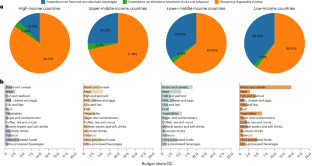Global food expenditure patterns diverge between low-income and high-income countries
IF 23.6
Q1 FOOD SCIENCE & TECHNOLOGY
引用次数: 0
Abstract
Globalization, income growth and changing cultural trends are believed to prompt consumers in low-income countries to adopt the more affluent diet of high-income countries. This study investigates the convergence of food expenditure patterns worldwide, focusing on total food expenditure, raw food categories and ultra-processed foods and beverages across more than 90 countries over the past decades. Contrary to prior belief, we find that food expenditure patterns of lower-income countries do not universally align with those of higher-income nations. This trend is evident across most raw food categories and ultra-processed foods and beverages, as the income level of a country continues to play a crucial role in determining its food expenditure patterns. Importantly, expenditure patterns offer estimates rather than a precise idea of dietary intake, reflecting consumer choices shaped by economic constraints rather than exact dietary consumption. Knowing how consumers allocate their budget among different food categories helps us understand their preferences, priorities and economic accessibility. This study investigates the convergence of budget shares for total food, stimulants, raw food categories and ultra-processed foods and beverages across more than 90 countries over the past decades.


低收入国家和高收入国家的全球食品支出模式存在差异
全球化、收入增长和不断变化的文化趋势被认为会促使低收入国家的消费者采用高收入国家更为富裕的饮食方式。本研究调查了全球食品支出模式的趋同性,重点关注过去几十年中 90 多个国家的食品总支出、生食类别以及超加工食品和饮料。与之前的观点相反,我们发现低收入国家的食品支出模式并不普遍与高收入国家一致。由于一个国家的收入水平在决定其食品支出模式方面仍然起着至关重要的作用,因此这一趋势在大多数生鲜食品类别以及超加工食品和饮料中都很明显。重要的是,支出模式提供的是膳食摄入量的估计值,而不是精确的概念,反映的是受经济限制而形成的消费选择,而不是确切的膳食消费。
本文章由计算机程序翻译,如有差异,请以英文原文为准。
求助全文
约1分钟内获得全文
求助全文

 求助内容:
求助内容: 应助结果提醒方式:
应助结果提醒方式:


